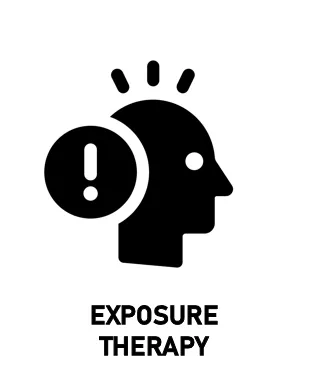Exposure Therapy – also known as Desensitisation – is a very common type of therapy used for some mental health conditions – especially those involving traumas or phobias.
This type of therapy involves an individual being gradually exposed to their fear/trauma, with a therapist setting up a programme for this.
Over time, the individual will gradually become accustomed to the problematic area that is being targeted – though this takes time.
The eventual aim is for the patient to overcome their problem. Relaxation methods are also commonly taught in this therapy.

The Science Behind Exposure Therapy
Exposure Therapy works on the idea that an individual who has problems with anxiety or trauma can be gradually exposed to their fear/past in a gradual manner that can help them overcome their distress.
Anxiety or trauma cause cognitive and emotional problems – a therapist will work with the patient to try and identify the problems surrounding the issue, and aims to break a pattern of thought that maintains the distress.
This is done slowly, with the aim that eventually the person will be less affected by their distress e.g. anxiety, trauma or phobia.
How Does Exposure Therapy Work?
Exposure Therapy can work in a number of different ways. It typically involves a patient having their thoughts and feelings about a distress challenged, and confronted head on – aiming for negative feelings being replaced by a state of calm.
Exposure Therapy is quite well structured, with it capable of treating many mental health conditions.
Exposure Therapy can be undertaken in many ways. As technological advancements continue, some people can use virtual reality technology to re-live traumas and confront them.
Others will be asked to imagine situations, while others will be physically exposed to their distress. It may be a combination of these methods.
Regardless of the method used, Exposure Therapy is completed slowly, and takes into account the needs of patients. Progress is monitored throughout the therapy.
Exposure Therapy can be difficult to complete, given that it involves confronting something distressful. But the therapy is always given in a safe and calm environment.
It is important for an individual to commit themselves to Exposure therapy – as this will maximise the chances of the treatment succeeding.
Techniques learned too should enable a person to avoid relapse in the future, and help them control their fears in a more positive way. Many people treated with Exposure therapy will see a big reduction in their symptoms.
When is Exposure Therapy Useful?
Exposure Therapy appears to be widely effective for many mental health conditions. It is most associated with Post-traumatic stress disorder – given its focus on lessening trauma.
Exposure therapy can feasibly treat any condition that involves any fear or past trauma. Anxiety disorders like General Anxiety Disorder, Social Anxiety Disorder or Phobias can successfully be treated by Exposure Therapy.
In fact, for many of these conditions, it is the first line of treatment. Obsessive-compulsive disorder is also widely treated by Exposure Therapy, with many finding it to be very useful.
How effective is Exposure Therapy?
Exposure Therapy appears to be a very effective treatment for many mental health conditions. It seems to be particularly effective at treating PTSD, especially when using virtual reality technology [1][2].
One large study concluded that Exposure Therapy was much more effective than Cognitive Behavioural Therapy when treating OCD [3].
The evidence for Exposure Therapy being a successful treatment for anxiety disorders like general anxiety disorder or phobias is positive too [4]. It appears to be particularly effective for phobias [5].
There is very little in the way of literature to suggest Exposure Therapy isn’t effective, though it isn’t suitable for everyone. Each person is different, and will enter therapy under different circumstances.
How to find a therapist?
It is recommended that you contact your GP and inform them of your problems. They will refer you to the relevant mental health team.
If you are aiming to use the private sector, you could ask your GP or someone you know for a recommendation. You can also look online – the British Association for Counselling and Psychotherapy have a therapist directory on their site.
See Also
- Therapy Home
- Everything You Need To Know About Talking Therapy
- FAQ’s About Talking Therapy
- Exposure Therapy: Everything You Need to Know
- The Advantages and Disadvantages of Exposure Therapy
- 8 Things You Should Know About Exposure Therapy
- 3 Examples of How Exposure Therapy Works
Disclaimer
This website should be used purely for informational purposes, and does not intend to, nor should it ever, be used as a replacement for professional medical advice.
We strive to keep all of our pages updated, and ensure that our website is full of factual and in-depth information. However, we encourage you to browse this website with care.
As a reminder, this website and all content within it cannot and should not replace the advice of a trained medical professional. You can read our full disclaimer at this link.
Helplines
If you are struggling with your mental health, help is available. With the right support and treatment, you can make a recovery. For information on helplines, or if you are in a state of crisis, please visit our crisis page by clicking on the relevant link for your geographical location (United Kingdom), (United States), (International). You can also see how to get mental health treatment and the process involved by clicking this link.
References
[1] Rothbaum, B. & Schwartz, A. (2002). Exposure therapy for posttraumatic stress disorder.. American Journal of Psychotherapy. 56 (1), p59-75.
[2] Krijn, M., Emmelkamp, P., Olafsson, R & Biemond, R. (2004). Virtual reality exposure therapy of anxiety disorders: A review. Clinical Psychology Review. 24 (3), p259-281.
[3] Abramowitz, J. S., Franklin, M. E., & Foa, E. B. (2002). Empirical status of cognitive-behavioral therapy for obsessive-compulsive disorder: A meta-analytic review. Romanian Journal of Cognitive & Behavioral Psychotherapies, 2 (2), p89–104.
[4] McNally, R. (2006). Mechanisms of exposure therapy: How neuroscience can improve psychological treatments for anxiety disorders. Clinical Psychology Review. 27 (6), p750-759.
[5] Chambless, D. L. & Ollendick, T. H. (2001). Empirically supported psychological interventions: Controversies and Evidence. Annual Review of Psychology. 52 (1): p685–716.






























